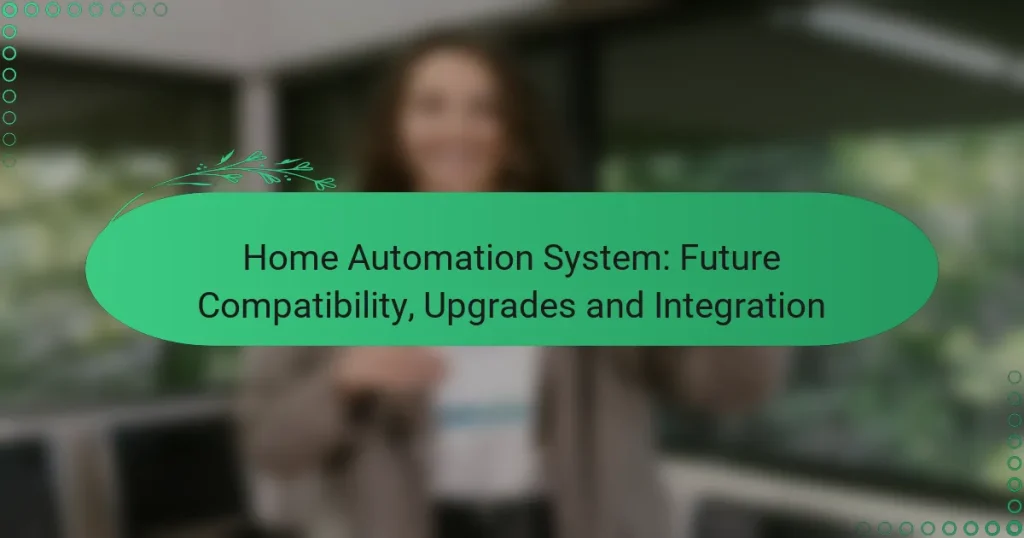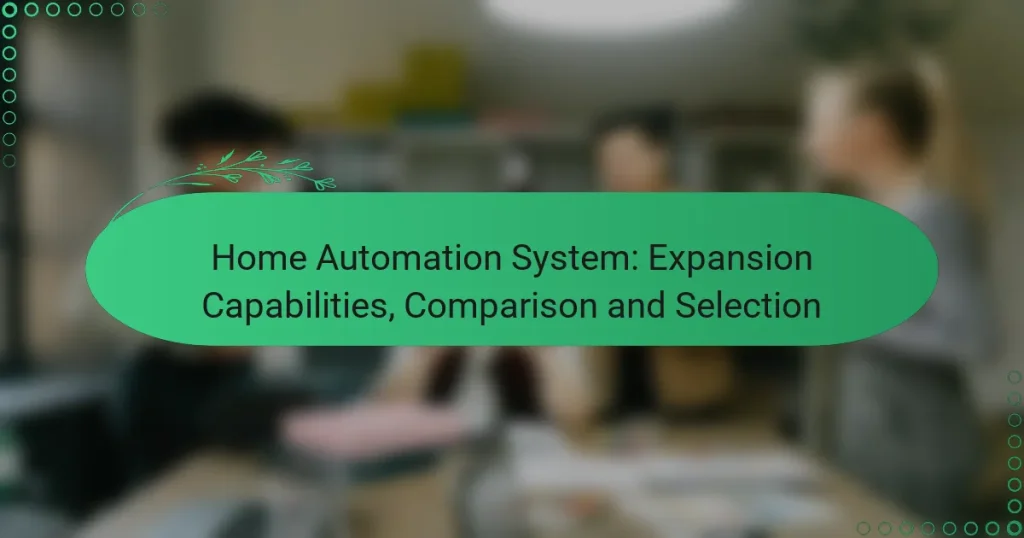Scalability in home automation systems is essential for homeowners looking to expand their smart environments seamlessly. It enables users to start with a few devices and gradually incorporate more as their needs change, ensuring flexibility and long-term usability. By choosing systems like Amazon Alexa, Google Nest Hub, or Samsung SmartThings, users can easily enhance their setups while considering integration capabilities and future-proofing technologies.
Home Automation System: Expansion Capabilities, Comparison and Selection
How does scalability impact home automation systems?
Scalability in home automation systems refers to the ability to expand and integrate additional devices and functionalities without significant disruption. A scalable system allows homeowners to start with a few devices and gradually add more as their needs evolve, ensuring long-term usability and flexibility.
Increased device compatibility
Scalability enhances device compatibility by enabling integration with a wider range of products from different manufacturers. Home automation systems that support common protocols, such as Zigbee or Z-Wave, can easily incorporate new devices, ensuring that users can choose from various options without being locked into a single brand.
This compatibility allows homeowners to mix and match devices, creating a customized setup that meets their specific needs. For instance, one can combine smart lights, thermostats, and security cameras from different brands, all functioning seamlessly together.
Enhanced user experience
A scalable home automation system significantly improves the user experience by providing a cohesive and intuitive interface for managing multiple devices. As users add more devices, the system can adapt, offering personalized settings and automations that enhance convenience and efficiency.
For example, a user can set up routines that automatically adjust lighting and temperature based on the time of day or occupancy, making the home more comfortable and energy-efficient. This adaptability ensures that as technology evolves, the system remains user-friendly and relevant.
Cost-effective expansion
Scalability allows for cost-effective expansion of home automation systems, as homeowners can invest in devices gradually rather than purchasing a complete system upfront. This approach helps spread out costs and enables users to prioritize essential devices first.
For instance, starting with a smart thermostat and gradually adding smart lighting or security features can be more budget-friendly. Homeowners can take advantage of seasonal sales or new product releases, ensuring they get the best value for their investments over time.
What are the best scalable home automation systems?
The best scalable home automation systems allow users to easily expand their smart home setups by adding new devices and features. Key options include Amazon Alexa, Google Nest Hub, and Samsung SmartThings, each offering unique capabilities and integration options.
Amazon Alexa ecosystem
The Amazon Alexa ecosystem is known for its extensive compatibility with a wide range of smart devices, making it highly scalable. Users can start with a few Alexa-enabled devices and gradually add more, such as smart lights, thermostats, and security cameras, all controlled through voice commands or the Alexa app.
When considering Amazon Alexa, look for devices that support the Alexa Voice Service. This ensures seamless integration and allows for easy updates as new features are released. Popular choices include the Echo Dot and Echo Show, which serve as hubs for controlling other devices.
Google Nest Hub
The Google Nest Hub offers a user-friendly interface and robust integration with Google services, making it a great choice for those already using Google products. Its scalability comes from the ability to connect with a variety of smart home devices, including lights, cameras, and smart displays.
To maximize the potential of the Google Nest Hub, consider devices that are compatible with Google Assistant. This will enhance your ability to control your home with voice commands and manage routines effectively. The Nest Hub Max, for example, provides additional features like a larger screen and built-in camera for video calls.
Samsung SmartThings
Samsung SmartThings is a versatile platform that supports a wide range of devices from various manufacturers, making it highly scalable. Users can create a centralized smart home system that integrates everything from lights to appliances, all managed through the SmartThings app.
When using SmartThings, ensure that the devices you choose are compatible with the SmartThings ecosystem. This will allow for better automation and control. Additionally, consider using the SmartThings Hub to connect devices that may not have direct Wi-Fi capabilities, enhancing your system’s overall functionality.
What factors should you consider for scalability?
When planning for scalability in a home automation system, consider device integration capabilities, cloud service reliability, and future-proofing technology. These factors ensure that your system can grow and adapt to new technologies and user needs over time.
Device integration capabilities
Device integration capabilities refer to how well your home automation system can connect with various smart devices. Look for systems that support a wide range of protocols like Zigbee, Z-Wave, and Wi-Fi to ensure compatibility with future devices.
Consider the number of devices you plan to add. A good rule of thumb is to choose a system that can handle at least double the number of devices you currently own to accommodate future expansion without performance issues.
Cloud service reliability
Cloud service reliability is crucial for the performance of your home automation system, as many features depend on cloud connectivity. Ensure that the service provider has a strong track record of uptime, ideally above 99%, to minimize disruptions.
Check for features like local control options that allow your devices to function even when the internet is down. This can be particularly important for critical functions like security systems.
Future-proofing technology
Future-proofing technology involves selecting systems that can adapt to new standards and innovations. Look for platforms that receive regular updates and support emerging technologies, such as voice control and AI integration.
Investing in modular systems that allow for easy upgrades can save you money in the long run. Avoid proprietary systems that lock you into specific hardware, as they may limit your options as new technologies emerge.
How to evaluate scalability in home automation?
Evaluating scalability in home automation involves assessing how well the system can grow and adapt to increasing demands. Key factors include the existing infrastructure, user requirements, and the level of support from vendors.
Assessing current infrastructure
Begin by examining your current home automation setup, including devices, network capacity, and integration capabilities. Identify any limitations that could hinder the addition of new devices or features.
Consider the types of protocols used, such as Zigbee or Z-Wave, and whether your existing hardware can support future expansions. A robust Wi-Fi network is essential for seamless connectivity as you scale up.
Analyzing user needs
Understanding user needs is crucial for determining scalability. Evaluate how many devices you currently use and anticipate future requirements based on lifestyle changes or technological advancements.
Engage with all household members to gather input on desired features and functionalities. This will help prioritize which aspects of the system need to be scalable, ensuring it meets evolving demands.
Reviewing vendor support
Vendor support plays a significant role in scalability. Research the reputation of manufacturers regarding updates, compatibility, and customer service. A reliable vendor should provide regular software updates and support for new devices.
Check if the vendor offers a clear roadmap for future product releases and how they plan to support existing customers as technology evolves. This foresight can prevent potential issues as you expand your home automation system.
What are the costs associated with scalable home automation?
Scalable home automation systems involve various costs that can vary significantly based on the complexity and features of the system. Key expenses include initial setup costs, ongoing subscription fees, and maintenance and upgrades, all of which should be carefully considered when planning your home automation project.
Initial setup costs
The initial setup costs for a scalable home automation system can range from a few hundred to several thousand dollars, depending on the number of devices and the complexity of the installation. Basic systems might include smart lights and a hub, while more advanced setups could feature security cameras, smart thermostats, and integrated home entertainment systems.
When budgeting, consider the cost of professional installation if needed, as well as any additional wiring or equipment that may be required. It’s wise to get quotes from multiple providers to ensure you are receiving a fair price for the setup.
Ongoing subscription fees
Ongoing subscription fees for home automation services typically range from $10 to $50 per month, depending on the features and level of service you choose. These fees often cover cloud storage for security footage, access to premium features, and customer support.
Some systems may offer a free tier with limited functionality, while others might require a subscription for full access. Always review the terms of service to understand what is included in your subscription and any potential increases in fees over time.
Maintenance and upgrades
Maintenance and upgrades are essential for keeping your home automation system running smoothly and securely. While many systems require minimal upkeep, budgeting for occasional hardware upgrades or replacements is advisable, especially as technology evolves.
Plan for potential costs associated with software updates or new device integrations, which can enhance functionality but may also require additional investment. Regularly reviewing your system’s performance can help identify when upgrades are necessary, ensuring your home automation remains efficient and effective.
What are the emerging trends in home automation scalability?
Emerging trends in home automation scalability focus on enhancing system capabilities while ensuring seamless integration and user experience. Key developments include the rise of AI-driven automation, interoperability standards, and smart energy management solutions, all of which contribute to more adaptable and efficient home systems.
AI-driven automation
AI-driven automation utilizes machine learning algorithms to optimize home automation systems, making them more responsive and intuitive. These systems learn user preferences over time, allowing for personalized automation that can adapt to changing lifestyles.
For example, AI can analyze data from various sensors to predict when a homeowner is likely to arrive, adjusting heating or lighting accordingly. This not only enhances comfort but also improves energy efficiency, reducing costs over time.
Interoperability standards
Interoperability standards are crucial for ensuring that different devices and systems can communicate effectively within a home automation setup. Standards such as Zigbee, Z-Wave, and Matter facilitate compatibility among various manufacturers, making it easier to scale systems as new devices are added.
When choosing devices, look for those that support these common standards to avoid compatibility issues. This approach allows homeowners to mix and match products from different brands without being locked into a single ecosystem.
Smart energy management solutions
Smart energy management solutions focus on optimizing energy consumption through automation and real-time monitoring. These systems can manage energy use across multiple devices, helping homeowners reduce their utility bills while minimizing their carbon footprint.
For instance, smart thermostats can learn user habits and adjust heating and cooling schedules accordingly, potentially saving 10-20% on energy costs. Additionally, integrating solar panels with smart energy systems can further enhance sustainability and reduce reliance on grid power.

